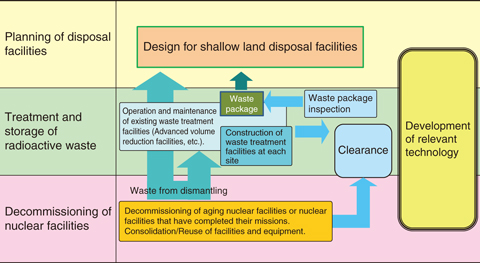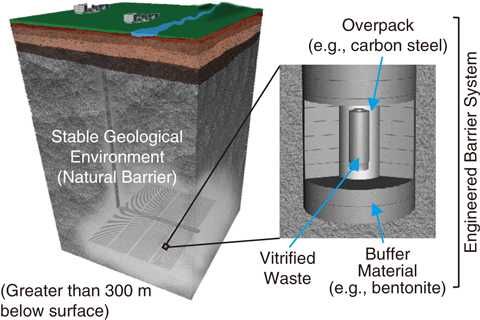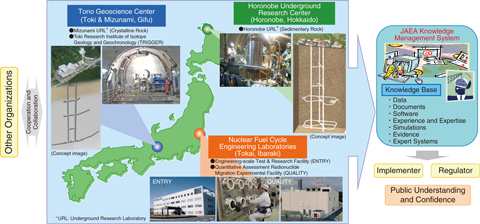
Fig.8-1 Outline of measures toward the decommissioning of nuclear facilities and the treatment and disposal of radioactive waste

Fig.8-2 Schematic view of the basic concept for the geological disposal of high-level radioactive waste in Japan

Fig.8-3 System for implementing JAEA R&D activities
Progress in the Decommissioning of Nuclear Facilities and the Treatment and Disposal of Radioactive Waste
Safe and efficient decommissioning of our nuclear facilities and treatment and disposal of radioactive waste are important issues to consider in our research and development (R&D) activities. We are currently setting up systems to accomplish these goals and developing the related technologies (Fig.8-1). We will be responsible for disposing of radioactive waste generated not only from our research facilities but also from universities, industrial facilities, and other sites. We have also worked on the development of an automatic analysis system for Strontium-90 in environmental samples as a contribution to the decommissioning and radioactive-waste management of the TEPCO’s Fukushima Daiichi NPS (1F). This research has already been related in Chapter 1, Topic 1-17.
R&D for the Treatment and Disposal of Radioactive Waste
Storage drums of radioactive waste should record the origin of the waste (e.g., a “natural uranium system” or “recovered uranium”). It is necessary for us to identify the records to properly treat and dispose of radioactive waste with drums. On the contrary, the Ningyo-toge Environmental Engineering Center has developed a method for measuring the γ-ray spectrum over a short time, and using the characteristic γ-ray spectrum to identify the drums at the external surface (Topic 8-1).
It is important to “predict how nitrate ion leaches from solidified asphalt bodies” and to “prepare for processing technologies not to affect the disposal environment”. Therefore, we researched the behavior of nitrate ions leaching from solidified asphalt bodies, and developed technology for removing these ions (Topic 8-2).
Approach to the Disposal of Radioactive Waste
For disposal, radioactive waste must be prepared in accordance with certain technical standards. These standards aim to prevent scattering, ensure a homogenous radioactive-waste mortar, and avoid harmful voids in the drum. Therefore, a filling test was conducted focusing on the fluidity of the mortar (Topic 8-3).
R&D to Improve the Technology and Reliability of Geological Disposal in Japan
Geological disposal is an option for long-term isolation of high-level radioactive waste (HLW) produced during nuclear-power generation from human environments. This is a critical issue with which the present generation must sensibly deal, and it will remain crucial irrespective of any revision to national nuclear-energy policy. In Japan, spent fuel from power reactors is reprocessed to extract reusable uranium and plutonium for power generation. The liquids separated from the spent fuel during chemical reprocessing are solidified into a stable glass form. Under the Japanese disposal concept, vitrified wastes are then encapsulated in a thick steel overpack surrounded by highly compacted bentonite and placed in a stable geological environment at a depth of more than 300 m below the surface (Fig.8-2). Implementing geological disposal of HLW is a long-term project that will last over 100 years. The project begins with site selection and continues to repository construction and operation, which will be followed by backfill for repository closure. It is thus of great importance to proceed efficiently with the project as a national responsibility by continuously improving its sound technical basis and applying these attitudes to implementation, regulatory activities, and most importantly, enhancement of public confidence. To this end, we have made, and will continue to make, steady progress in R&D in various fields such as geoscience, repository engineering, and safety assessment to improve the technologies used for reliable geological disposal in Japan.
At present, our R&D focuses particularly on projects at two underground research laboratories (URLs)—one at Mizunami, which researches crystalline rocks, and the other at Horonobe, which researches sedimentary formations (Fig.8-3). Multidisciplinary investigations are ongoing because the reliability of various investigative techniques should be tested and verified before the site-characterization program begins (Topics 8-4, 8-5, 8-6, and 8-7). In addition, studies on tectonics, volcanic and faulting activities, and the like are in progress to evaluate the long-term stability of geological environments in Japan (Topic 8-8).
The Toki Research Institute of Isotope Geology and Geochronology (TRIGGER) was established in November 2014 for the development of dating techniques using advanced equipment for isotope geology and geochronology. In parallel with such geoscientific efforts, we are conducting an extensive study to assess the performances of the disposal system, engineered barrier systems, and long-term chemistry and migration of radionuclides at Tokai to expand our knowledge base for geological disposal (Topics 8-9 and 8-10). These studies exploit data and information about geological environments that were obtained through geoscientific research at both URLs. The prototype knowledge-management system that was developed in 2010 is being improved to systematically provide and transfer multiple associated R&D results to both implementers and regulators and to ensure their safety. Furthermore, the results of the R&D activities have been summarized as an unconventional web-based report (CoolRep), which has been available on the Japan Atomic Energy Agency (JAEA)’s public website.
Implementing Safety Measures at the TRP and Enhancing Reprocessing Technologies
After the Great East Japan Earthquake and the accident at 1F, various emergency-safety measures were implemented at the Tokai Reprocessing Plant (TRP). To reduce the probability of hazards at the TRP, efforts have been focused on solidifying and stabilizing the highly active liquid waste (HALW) at the Tokai Vitrification Facility and the plutonium solution at the Plutonium Conversion Development Facility as soon as possible.
Vitrification of all the stored HALW is estimated to require two decades. Thus, an advanced glass melter is under development to make steady progress on the solidification and stabilization of HALW.
For low-level radioactive effluents, a cement-based solidification method accompanying a nitrate-ion decomposition process has been developed to reduce the environmental impact.
As an approach to the advancement of nuclear-fuel reprocessing technology, we measured the heating efficiency during the microwave-heating direct-denitration method, by which a microwave heats a mixture of uranyl nitrate and plutonium nitrate solution to form oxide powder for use in MOX fuel pellets. In this conversion process, the heating efficiency is very important for shortening processing time and improving energy-saving performance reducing power consumption. However, since there have not been reported cases about heating efficiency of MH method for detail, we have investigated the heating efficiencies were measured at the changing the kind of specimen and the specimen height. As a result, important knowledges to be used for new MH devise improvement in the future could be obtained (Topic 8-11).